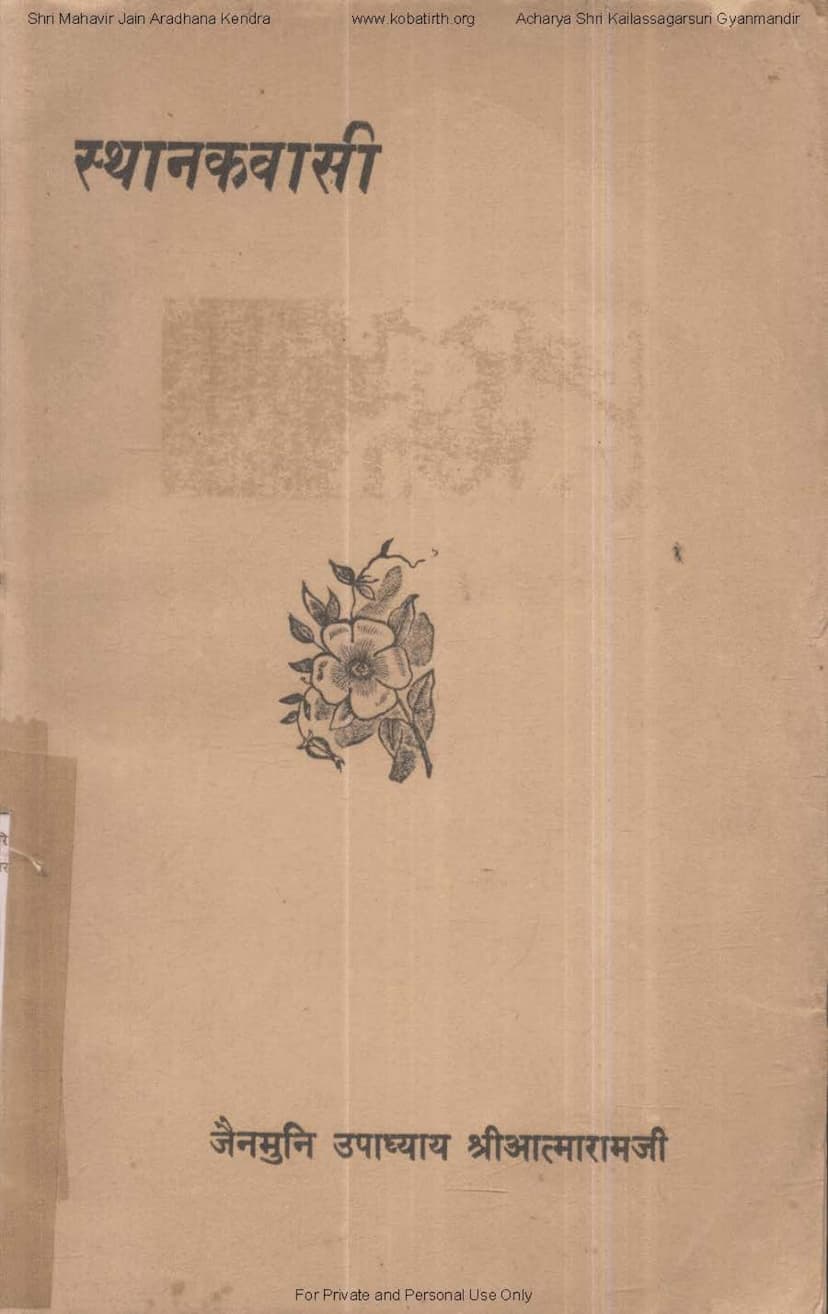Sthanakvasi
Added to library: September 2, 2025

Summary
Here's a comprehensive summary of the Jain text "Sthanakvasi" by Aatmaramji Maharaj, based on the provided pages:
Book Title: Sthanakvasi Author: Jain Muni Upadhyay Shri Aatmaramji Maharaj Publisher: Lala Valayati Ram Kasturi Lal Jain, Ludhiana
Core Argument and Purpose: The book "Sthanakvasi" by Upadhyay Shri Aatmaramji Maharaj aims to clarify the meaning and significance of the term "Sthanakvasi" within Jain tradition, particularly within the Shvetambara sect. The author asserts that the term encompasses both "dravya" (material/physical) and "bhava" (spiritual/mental) aspects, and that understanding these dual meanings is crucial for spiritual progress and achieving liberation (moksha).
Key Concepts and Explanations:
-
Origin and Meaning of "Sthanakvasi":
- The term "Sthanakvasi" refers to the Jain tradition that does not consider idol worship (murti-puja) as prescribed by the scriptures (agams).
- The word is derived from "Sthanak" (place/residence) and "Vaasi" (dweller).
- "Sthanak" and "Sthan" are essentially synonymous, meaning a place to stay.
- Therefore, a "Sthanakvasi" is one who resides in a place (Sthanak) that is prescribed by the scriptures, in both material and spiritual senses.
-
Dual Interpretation: Dravya (Material) and Bhava (Spiritual):
- Dravya Sthanak (Material Residence):
- This refers to the physical dwelling places prescribed for Jain monks (Shramanas) and lay followers (Shramana-upasakas).
- These places are called "Upashrayas" or "Vastis."
- The book elaborates on the characteristics of these Upashrayas as described in Jain Agams (scriptures like Acharaanga and Prashnavyakaran Sutras). They must be:
- Vivikt (secluded/isolated) from worldly activities and disturbances.
- Prashasta (auspicious/pure), free from insects, living beings (especially trasa beings), and potential harm to one's vows.
- Not specifically built for monks but rather used by them, meaning the construction should not involve significant harm or attachment for the monks.
- Clean, well-maintained, and free from avoidable sins (a-savadyopaashray).
- The author notes that while "Upashraya" was used in one tradition, the term "Sthanak" was adopted by the Sthanakvasi sect, possibly to emphasize a more refined or spiritually focused abode, without any fundamental meaning difference.
- Monks residing in these pure, prescribed material places are Dravya Sthanakvasis.
- Bhava Sthanak (Spiritual Residence):
- This refers to the inner state of the soul and its adherence to spiritual practices.
- The ultimate "Bhava Sthanak" is Moksha (Liberation), the eternal, unwavering abode of the Siddhas.
- Attaining Moksha requires the soul to reside in spiritual "Sanyam-sthan" (places of self-restraint/conduct).
- These spiritual places include the different types of Charitra (conduct) described in Jainism: Saamaayika, Chhedopasthaapaniya, Parihaara-vishuddhi, Sukshma-samparaaya, and Yathaakhyaata.
- Yathaakhyaata Charitra (perfect conduct) represents the most pure and ultimate spiritual residence.
- A monk who diligently practices these spiritual disciplines, residing in these inner states of conduct, is considered a Bhava Sthanakvasi.
- Dravya Sthanak (Material Residence):
-
The Sthanakvasi Sect:
- Historically, the term "Sthanakvasi" initially referred to highly ascetic Jain monks who lived in these designated "Sthanaks."
- Over time, as with terms like "Shvetambara" and "Digambara," the name became associated with the entire sect or tradition that followed these principles, including the lay followers.
- The author emphasizes that this naming convention is not inappropriate, as the term reflects the core principles of the tradition.
-
Interconnection of Dravya and Bhava:
- The book stresses that both material purity (Dravya Shuddhi) and spiritual purity (Bhava Shuddhi) are essential for spiritual advancement.
- While residing in pure, secluded places (Dravya Sthanak) aids in spiritual progress, it is the cultivation of inner spiritual conduct (Bhava Sthanak) that ultimately leads to liberation.
- The author connects this to the idea that the term "Sthanakvasi" applies to Siddhas (liberated souls), Tirthankaras and Kevalis (omniscient beings), and then to Jain monks who strive to attain these states by residing in spiritual places (Sanyam-sthan).
-
Equivalence of Sthanak and Upashraya:
- The author reiterates that the terms "Sthanak" and "Upashraya" are essentially synonymous in their meaning of a prescribed residence for monks.
- The difference in usage is attributed to sectarian differences within the Shvetambara tradition, rather than any difference in the scriptural concept of a suitable dwelling.
-
Inclusivity and the Essence of the Term:
- The book aims to provide a scholarly, unbiased perspective on the term "Sthanakvasi."
- The author encourages readers to strive to become both "Dravya Sthanakvasi" and "Bhava Sthanakvasi" to achieve the ultimate goal of liberation.
- The ultimate goal is to reach the "Moksha-sthan" (place of liberation), which is the highest and most desirable state.
In essence, "Sthanakvasi" by Aatmaramji Maharaj is a theological exploration of the term, defining it as adherence to scripturally prescribed dwelling places (both physical and spiritual) and highlighting the dual aspect of material and spiritual purity required for spiritual attainment within the Jain path.